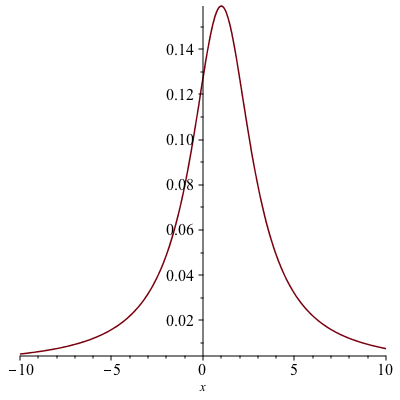In this note, we derive the so called Tsiolkovsky rocket equation or simply rocket equation. It is given by
\begin{equation}
\label{eq:rocket}
\Delta v=v_e\ln\frac{m_0}{m_f}=I_{\mathrm{sp}}g_0\ln\frac{m_0}{m_f}
\end{equation}
where
- $\Delta v$ is the maximum change of velocity of the vehicle;
- $v_e=I_{\mathrm{sp}}g_0$ is the effective exhaust velocity;
- $g_0=9.8\ \mathrm{m}/\mathrm{s}^2$ is the gravitational acceleration of an object in a vacuum near the surface of the Earth;
- $m_0$, called wet mass, is the initial mass, including propellant;
- $m_f$, called dry mass, is the final total mass without propellant.
The equation \eqref{eq:rocket} is named after the Russian scientist Konstantin Eduardovich Tsiolkovsky (September 5, 1857 – September 19, 1935). He is dubbed the father of Russian rocket science. It is also called fuel equation.
By the Newton’s second law of motion, the net external force $\vec{F}$ to the change in linear momentum $\vec{P}$ of the whole system (including rocket and exhaust) is
$$\vec{F}=\frac{d\vec{P}}{dt}=\lim_{\Delta t\to 0}\frac{\Delta\vec{P}}{\Delta t}$$
$\Delta\vec{P}=\vec{P}_2-\vec{P}_1$, where $\vec{P}_1=m\vec{V}$ is the momentum of the rocket at time $t=0$ and $\vec{P}_2=(m-\Delta m)(\vec{V}+\Delta\vec{V})+\Delta m\vec{V}_e$ is the momentum of the rocket and exhausted mass at $t=\Delta t$. Here, with respect to the observer, $\vec{V}$ is the velocity of the rocket at time $t=0$, $\vec{V}$ is the velocity of the rocket at time $t=\Delta t$, $\vec{V}_e$ is the velocity of the mass added to the exhaust and lost by the rocket during tim $\Delta t$, $m$ is the mass of the rocket at time $t=0$, and $m-\Delta m$ is the mass of the rocket at time $t=\Delta t$. The velocity of the exhaust $\vec{V}_e$ in the observer frame is related to the velocity of the exhaust in the rocket $\vec{v}_e$ by $$\vec{v}_e=\vec{V}_e-\vec{V}$$ or $$\vec{V}_e=\vec{V}+\vec{v}_e$$ Now, $\Delta\vec{P}$ can be written as $$\Delta\vec{P}=m\Delta\vec{V}+\vec{v}_e\Delta m-\Delta m\Delta\vec{V}$$ Since $\Delta m\to 0$ as $\Delta t\to 0$, we have \begin{equation}\label{eq:rocket2}\vec{F}=m\frac{d\vec{V}}{dt}+\vec{v}_e\frac{dm}{dt}\end{equation} If there are no external forces, then $\vec{F}=0$ i.e. $\frac{d\vec{P}}{dt}=0$ (conservation of linear momentum). \eqref{eq:rocket2} then becomes the separable differential equation \begin{equation}\label{eq:rocket3}-m\frac{d\vec{V}}{dt}=\vec{v}_e\frac{dm}{dt}\end{equation} Assuming that $\vec{v}_e$ is constant (Tsiolkovsky’s hypothesis) $v_e$, and integrating \eqref{eq:rocket3} we have $$\int_v^{v+\Delta v}dv=-v_e\int_{m_0}^{m_f}\frac{dm}{m}$$
where $v=|\vec{V}|$, $\Delta v=|\Delta\vec{V}|$, $m_0$ is the initial total mass and $m_f$ is the final mass. Finally, evaluating the integral yields the rocket equation \eqref{eq:rocket}.
From \eqref{eq:rocket}, we obtain
\begin{equation}
\label{eq:rocket4}
\frac{m_0-m_f}{m_0}=1-\frac{m_f}{m_0}=1-e^{-\frac{\Delta v}{v_e}}
\end{equation}
The equation \eqref{eq:rocket4} gives rise to the percentage of the initial total mass which has to be propellant. This tells us how efficient the rocket engine is as shown in the following example.
Example. Let us consider an SSTO (Single-Stage-To-Orbit) rocket. (Most rockets we are seeing are two-stage-to-orbit or three-stage-to-orbit ones.) The rocket uses liquid hydrogen/liquid oxygen for its propellant, so specific impulse is about $I_{\mathrm{sp}}=350$ s. The exhaust velocity is then given by $v_e=3.43$ km/s. $\Delta v$ needed to get the rocket to a 322 km high LEO (Low Earth Orbit) is 8 km/s. With these values \eqref{eq:rocket4} is evaluated to be
$$1-e^{-\frac{\Delta v}{v_e}}=0.9$$
This means that 90% of the initial total mass has to be propellant. The remaining 10% is for the engines, the fuel tank, and the payload. The payload would account for only about 1% of the initial total mass. This kind of rocket is obviously very inefficient and expensive.
In the Sci-Fi novella The Wandering Earth by Liu Cixin (there is also a movie of the same title on Netflix), the Sun will soon become a supernova and facing the ultimate cataclysmic extinction event, people on Earth turns their entire planet into a spaceship and attempt to relocate it to Proxima Centauri which is the closest star to the Sun (about 4.2 light-years). This is an extremely bold idea even in Chinese scale. (Well, they built the Great Wall!) Disappointingly though, in here, I showed using the rocket equation that it is not even possible for startship Earth to break away from its orbit around the Sun.

